Abstract
The ability to differentiate between various fish species plays an essential role in aquaculture. It helps to protect their populations and monitor their health situations and their nutrient systems. However, old machine learning methods are unable to detect objects in images with complex backgrounds and especially in low-light conditions. This paper aims to improve the performance of a YOLO v5 model for fish recognition and classification. In the context of transfer learning, our improved model FishDETECT uses the pre-trained FishMask model. Then it is tested in various complex scenes. The experimental results show that FishDETECT is more effective than a simple YOLO v5 model. Using the evaluation metrics Precision, Recall, and mAP50, our new model achieved accuracy rates of 0.962, 0.978, and 0.995, respectively.
Key Contribution:
In this study, we present the FishDETECT model, an innovative deep learning architecture specifically designed for underwater species recognition in the context of aquaculture. Our research offers improved accuracy, robustness, efficiency, and generalizability. This innovation has the potential to significantly impact aquaculture practices, research, and conservation efforts, representing a substantial advancement in the field of aquatic species recognition.
1. Introduction
Aquaculture has become an elegant research field for its important contribution in global food production and economic growth. Increasing global populations means aquaculture provides a more sustainable and environmentally friendly way of producing animal protein than traditional fishing. In addition, aquaculture offers a viable alternative to wild fish stocks, thereby contributing to food security and sustainable management of aquatic resources []. In terms of value, aquaculture production reached a record USD 263.6 billion in 2019, accounting for 48% of the total value of global fish production []. In addition, aquaculture can have economic benefits by creating jobs and stimulating local economic development. Approximately 20 million people are employed in the aquaculture sector worldwide []. As a result, aquaculture plays a significant role in enhancing food security and alleviating poverty in various regions across the globe.
Conventional aquaculture management typically necessitates direct interaction between the fish farmer and the fish. This stressful method can influence the growth of these species [,]. Automated fish species recognition offers numerous advantages. Initially, it enables the more efficient monitoring of fish growth, health, and behavior within the aquatic environment. This proactive approach enables fish farmers to promptly identify and address fish health issues or overpopulation concerns, preventing potential harm to the aquatic ecosystem and fish stocks []. Moreover, the automated classification of fish types facilitates feeding management, allowing for better control over the quantity and timing of food distribution, tailored to the specific fish species and their sizes. This, in turn, enhances feeding efficiency, reduces expenses, and mitigates environmental pollution by averting overfeeding of fish [,]. Fish recognition technology holds the potential to significantly contribute to sustainability and environmental conservation by enhancing fish stock management. With the ability to swiftly identify fish species and monitor their development, fish farmers gain deeper insights into the ecological impact of their operations. This knowledge empowers them to make well-informed decisions aimed at preserving the sustainability of their aquaculture production, thereby promoting responsible environmental stewardship [,]. Nonetheless, the manual processing of underwater videos and photos proves to be both time-consuming and resource-intensive, incurring substantial expenses. The tracking of fish species is significantly impacted by unrestricted environmental elements such background complexity, brightness, camouflage, and clutter. Its continuous movements and similar shapes make it challenging to distinguish between different types []. Therefore, automatic fish detection processing of underwater videos is an excellent alternative []. The integration of new technology into the species recognition process has the potential to bring significant enhancements to production []. One such promising development is the utilization of computer vision for fish species recognition, a recent technique with the potential to yield several advantages. This includes the rapid detection of fish diseases and various other benefits, which we will discuss further in this study [,]. The introduction of deep learning represents a breakthrough in object detection that makes it possible to find objects of various kinds.
This paper presents a study employing advanced deep learning and computer vision techniques to automate the recognition of fish species. A comprehensive overview of previous studies on the same subject, along with their findings, will be discussed in Section 2. Section 4 presents the data collection phase and the data pre-processing methods used in this study. Moreover, we emphasize image segmentation techniques, explain our FishDETECT model’s training process, and describe how an embedded device is integrated. Then, in Section 5, we illustrate the study’s findings and evaluate the improved model performance over previous approaches. Finally, Section 6 concludes the work with some remarks.
2. Related Work
Fish species detection and recognition is an important area of research in aquaculture. It can help the farmer avoid costly and time-consuming human intervention. In this context, many studies have been conducted to recognize fish species using machine learning techniques through several methods. In a recent study, Vikram Deep et al. worked on the fish4knowlge dataset. They applied sharpening operations on the images to improve its qualities. Subsequently, a comparison between several algorithms showed that the hybrid DeepCNN-KNN method is the best, with an accuracy rate that reaches []. Frank Storbeck et al. acquired length and height data from different locations for each fish type. After training the neural network, the model for recognizing fish types on the basis of their height and length is generated. Specific interventions such as deleting non-useful connections from the nodes were applied to the network architecture. The model achieved an accuracy of . Other fish-specific measurements that are detectable by the camera can be taken in this study. Training the neural networks with the diagonal length, width, and surface area of the fish can improve the fish type recognition task []. Many other studies have used the computer vision techniques for fish species classification. Ling Yang et al. developed a computer vision model for fish detection. They have extensively discussed the obstacles encountered, such as similarity of fish colors, high-density scene, darkness, and low resolution. A 3D imaging acquisition system for fish behavior analysis is implemented. The model is trained using deep learning techniques. Other preprocessing techniques can be introduced in this study to remedy the problems associated with the complexity of the scenes. Binarization of the acquired images can give more accurate results than gray image conversion, for example []. For a fish classification based on fish skin, color, and texture features, Jing Hu et al. presented a multi-class support vector machine method (MSVM). Images are captured with a mobile smartphone. Six groups of feature vectors are created. Directed Acyclic Graph Multiple Support Vector Machines (DAGMSVM) is selected in this study as the best classifier with an accuracy ranging from to depending on the type of species. Image quality is a key element in this study, as classification is based on fish skin, color, and texture features. A professional camera can improve classification task better than a smartphone camera []. Classification using Deep Convolutional Neural Network techniques is very efficient. Praba Hridayami et al. proposed a fish recognition method based on deep convolutional neural networks. The VGG16 model, which has been pre-trained on ImageNet, is used for transfer learning. A dataset of 50 species was used in this study. The CNN model is trained on four different types of image in this dataset: RGB color space image, blending image, canny filter image, and RGB image mixed with blending image. The results of the RGB image mixed with blending image are the best, with an accuracy of []. Zhiyong Ju et al. built a fish type recognition algorithm based on improved AlexNet model. A new model Fish-AlexNet is developed in this study for use in transfer learning. The improved AlexNet model is trained on a dataset containing 19,717 fish images, which are categorized into 16 classes. This new proposed model has shown a high efficiency []. The four deep CNN architectures, VGG16, VGG19, ResNet, and Inception, were used by Anderson Aparecido dos Santos et al. The comparison between VGG16, VGG19, ResNet, and Inception showed that Inception is the best. A new method of fish classification is proposed in this study. It is based on the Inception weights to achieve an accuracy of . This method is trained on a dataset of 35 species and 12 fish families []. Simegnew Yihunie Alaba et al. proposed a model that starts with object detection using CNN. This is a useful method for the case where more than one fish appears in the image. MobileNetv3-large is used to extract the most important features of the image. These features enable effective fish classification. The results showed that the accuracy of this model reached []. Image segmentation stands as a crucial technique within the realm of computer vision. This technique plays a pivotal role in pinpointing and recognizing objects present within an image. By breaking down an image into coherent sections, it becomes notably more straightforward to identify particular objects or regions of interest. This method is essential in various tasks, including object identification, object tracking, and understanding the spatial arrangement within a scene. Juan Carlos Ovalle et al. propose a deep learning model for fish recognition and length estimation. The similarity of colors, shapes, and textures of the fish can make identification difficult. To resolve this problem, an image segmentation technique is adapted using the Mask R-CNN algorithm. MobileNet-V is introduced in this work to estimate the fish length. Coco is used as a pre-trained model despite the large volume of dataset used. Fine-tuning techniques are not applied to adapt the pre-trained model to the identification task []. YOLO, “You Only Look Once”, is a popular method for object detection in computer vision. YOLO is a machine learning algorithm that can detect and classify objects in images or videos in real time. The results of object detection using this method are generally more accurate than the traditional methods. Many studies have used YOLO to solve problems related to object classification in computer vision. Joseph Redmon et al. pre-trained an object detection model on ImageNet-1000 before re-training it with a new model combining YOLO and Fast R-CNN. This study did not focus on detection efficiency with poor-quality scenes []. Du Juan compared versions one and two of YOLO with other detection frameworks such as Faster R-CNN, and the results showed that yolo accuracy with YOLO is the highest. This study did not go into the architecture of YOLO to try to improve it []. Ref. [] presents a comprehensive review of single-stage object detectors, specifically YOLOs, regression formulation, their architecture advancements, and performance statistics. Youssef Wageeh et al. combined the two algorithms retinex and YOLO. Retinex is used to improve the quality of images, and YOLO is used to detect fish from images that are already processed, to count their number, and to follow their paths []. A comparison was made between YOLO v2 and Mask R-CNN in the task of detecting the ball in a handball game, showing that Mask R-CNN is more accurate in the detection phase. The YOLO v2 and R-CNN models were pre-trained with the COCO dataset. Despite expanding the dataset with more examples of images from other sports, the accuracy of the models did not exceed 43% using the F1 score metric []. The two methods YOLO v3 and Mask R-CNN were combined by Haigang Hu et al. to implement a new method that detects residual feeding in a crab breeding tank, with images acquired in real time. YOLO detects the remaining food and the swimming of the crab. Mask R-CNN performs the segmentation and counts the number of residual foods. Despite the model being improved compared with previous methods, the results show that some residual foods are not detected. Fine-tuning applied to the pre-trained model can improve the detection results []. Jin-Hyun Park et al. proposed a method designed with YOLO to detect and count the number of species that are dangerous and can destroy the ecosystem. The proposed method achieves an accuracy of and , respectively, of two species, Bluegill and Largemouth bass, which are considered to be dangerous fish [].
3. Background
3.1. YOLO v5 Algorithm
yolov5 (You Only Look Once version 5) is a deep learning algorithm and architecture used for real-time object detection in images and videos. It is part of the YOLO family of object detection models, which are known for their speed and accuracy in detecting and classifying objects within images and video frames. YOLO models work by dividing an image into a grid and predicting bounding boxes and class probabilities for objects within each grid cell. YOLO v5 is an evolution of the earlier YOLO versions, aiming to improve upon their accuracy and efficiency. The computer vision community has widely adopted YOLO v5 and used it for a variety of purposes, such as surveillance systems, autonomous vehicles, and object detection in images and videos [].
3.2. Image Segmentation with U-Net
In the last 50 years, image segmentation research has yielded ground-breaking discoveries, with classical techniques like as thresholding, pixel clustering, and edge detection [] serving as the basis of the algorithms. In recent years, new approaches to image processing have emerged. Recently, a wave of artificial neural network algorithms has generated interest. Despite the abundance of literature on segmentation, only a few people are actively involved in data collection. Instead of choosing, the emphasis was on enhancing the accuracy of the segmentation task, as evidenced by research using deep neural networks such as U-net, which is an extension of FCN [,] and Mask R-CNN []. In this paper, we focus on U-net as a deep learning algorithm in the process of image segmentation. With U-net, we train our CarMask model to generate the mask of the fish found in images.
3.3. Transfer Learning
Transfer learning is a machine learning technique where a model developed for a particular task is reused as the starting point for a model on a second task. It leverages the knowledge gained while solving one problem and applies it to a different but related problem. In computer vision, transfer learning is a widely utilized method where a pre-trained model from a huge database is used as a starting point to complete a particular task. The use of a pre-trained model that has already learned general features from a similar task reduces time compared to starting from scratch and training a new model.
3.4. Roboflow Platform
Roboflow is a platform designed to manage and preprocess their data for training machine learning models, particularly in the field of computer vision. It focuses on simplifying the process of creating and managing datasets for tasks like image classification and object detection. Roboflow provides a range of tools and features, including annotation and labeling data, bounding boxes for object detection, segmentation masks, data preprocessing, and data augmentation.
3.5. Keras Library
Keras is an open-source deep learning framework renowned for its user-friendly and intuitive interface. It simplifies the process of building and training neural networks by providing a high-level API that abstracts away much of the complexity associated with deep learning. With Keras, users can easily define and customize neural network architectures, stack different types of layers, specify loss functions and optimization algorithms, and evaluate model performance. Originally designed to work with multiple backend libraries, Keras has become synonymous with TensorFlow, establishing itself as the preferred choice for building and training neural networks within the TensorFlow ecosystem. It boasts an extensive documentation and a wealth of pre-trained models, making it suitable for both beginners and experienced machine learning practitioners seeking an accessible yet powerful tool for deep learning tasks.
4. Methodology
4.1. Data Collection
In this work, three datasets were used to improve the performance and accuracy of our FishDETECT fish species detection and classification model:
4.1.1. CarMask Dataset
The CarMask dataset contains more than 4500 images of cars captured from different positions with their appropriate masks. The images in this dataset are of different sizes. It is obtained from the kaggle platform [].
4.1.2. FishSpecies Dataset
The FishSpecies dataset represents nine different seafood types collected from a supermarket in Izmir, Turkey, for a university–industry collaboration project at Izmir University of Economics, and the work was published in Innovations in Intelligent Systems and Applications Conference, Istanbul, Turkey 2020. As shown in Figure 1, the dataset includes Gilt Head Bream, Red Sea Bream, Sea Bass, Red Mullet, Horse Mackerel, Black Sea Sprat, Striped Red Mullet, Trout, and Shrimp image samples. It contains 9450 images of fish distributed over the different species, as shown in Table 1.
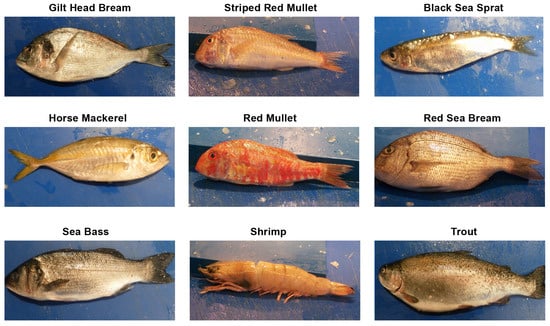
Figure 1.
Samples of fish images in FishSpecies dataset.

Table 1.
The label distribution in FishSpecies dataset.
4.1.3. FishMask Dataset
This dataset is built in this work. It contains all the images containing fish masks in the FishSpecies dataset. These masks were predicted using the model for predicting car masks from images of cars after applying fine-tuning.
4.2. Data Preprocessing
The Roboflow platform is used for the preprocessing, labelling, and bounding box of both FishSpecies and FishMask datasets. Several preprocessing techniques are exploited, such as Auto-orient, Resize, and Auto-adjust Contrasts. Other data augmentation mechanisms developed by roboflow platform are applied, such as Flip, Rotation, Grayscale, and Brightness. Data augmentation can also reduce overfitting. Image preprocessing procedures are used to improve the model’s performances during the training phase. At the end of the task, Roboflow splits the data from each dataset into 3 parts: training, validation, and test. The partitions are adjusted so that 70% of the data are for training, 15% for validation, and 15% for test.
4.3. A Deep Learning-Based New Architecture for Underwater Species Recognition
The objective of the architecture proposed in this work is to achieve the most optimal results in the phases of fish object detection and type recognition of these species. As illustrated in Figure 2, the architecture of our system consists mainly of the following elements.
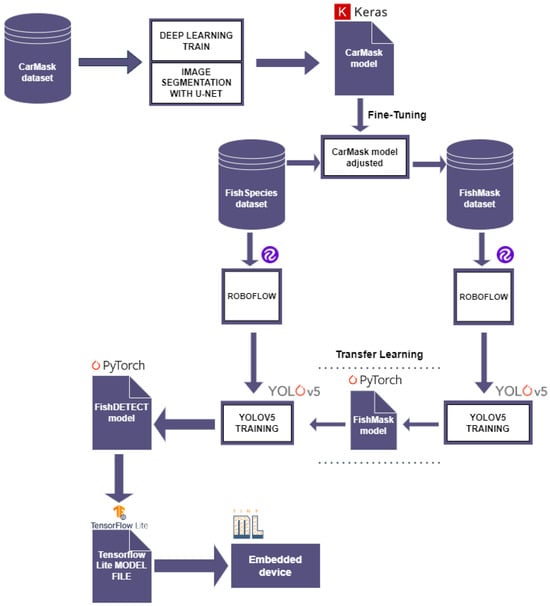
Figure 2.
The workflow of FishDETECT model.
4.3.1. CarMask Model
The model is trained on the CarMask dataset using the Keras library. Image segmentation is carried out with the U-net convolutional neural network architecture. It allows us to segment the image for object detection. Subsequently, the model generates the appropriate mask for the found object. After applying fine-tuning to the CarMask model, the latter becomes capable of generating the appropriate fish masks from the FishSpecies dataset. Using the CarMask Model, the FishMask dataset is created. The model takes as input the FishSpecies dataset, which contains fish images, and generates new images containing their predicted masks. The generation of masks helps to recognize the type of fish from its shape.
4.3.2. Fine-Tuning Process
Fine-tuning is a technique that involves adjusting a pre-trained model on a specific task using new data while retaining some of the previously learned weights. Firstly, as shown in Figure 3, we began by collecting a few images of fish and creating the appropriate masks manually. The images were annotated so that they could be linked to their masks. Secondly, during the preprocessing phase, all the images were resized to normalize them. Given the small number of images collected, a data augmentation operation was applied to better re-train the model. The previously trained CarMask model is then loaded. The output layer is removed and replaced by another layer suitable for predicting fish masks, whose number of channels is one, since segmentation is binary. The learning rate is lower than that used in the initial training. After this fine-tuning phase, the model is re-trained and validated. Finally, the CarMask model is generated with its new prediction behavior.
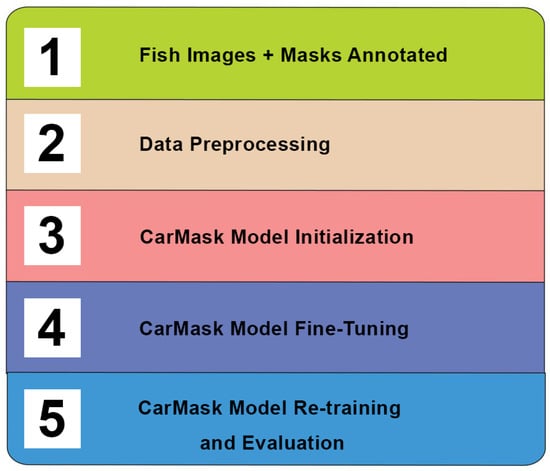
Figure 3.
The fine-tuning process.
4.3.3. FishMask Model
Once the fishMask dataset is created, labeling, preprocessing, and bounding box procedures are applied using the Roboflow platform. The data generated by Roboflow are split into training, test, and validation sets before being used for training with YOLO v5. The model is trained for 30 epochs. Figure 4 shows the training phase of the model. A PyTorch FishMask Model has been created to facilitate the detection of fish objects and automate species recognition from images containing masks. Through the process of transfer learning, the FishMask model enhances the performance of the final FishDETECT model, particularly in environments where distinguishing fish colors is challenging due to darkness.
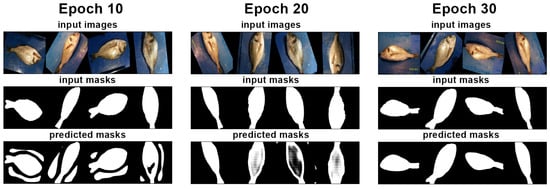
Figure 4.
Progress of FishMask model training.
4.3.4. Our Improved Model FishDETECT
Based on the weights of the previous model, the fish species recognition training is carried out on the FishSpecies dataset using YOLO v5. The labeling, preprocessing, and bounding box annotation are carried out via the Roboflow platform. Subsequently, a PyTorch FishDETECT model is finally ready to be deployed in an embedded environment. To make it easier to use in TinyML, it has been converted into a TensorFlow Lite model in version 2.10.
4.3.5. Model Integration into an Embedded Device
In this part, we proceed to the integration of our model in a constrained performance device. We use a Linux-based device and high-resolution camera. We have successfully integrated our FishDETECT model into the device, which utilizes a Raspberry Pi-4 and camera, enabling it to proficiently recognize fish species. This implementation has revolutionized the way we identify and classify various fish species. By harnessing the power of Raspberry Pi-4, a versatile single-board computer, and coupling it with a high-resolution camera, we have created a powerful system capable of capturing and processing images in real time. Through extensive training and fine-tuning of the AI model, the device has acquired the ability to accurately analyze intricate details and distinct features specific to various fish species. Leveraging deep learning algorithms, the embedded AI model efficiently categorizes the captured images, providing valuable insights about the present species. This breakthrough development not only facilitates scientific research and environmental monitoring but also empowers enthusiasts and professionals alike to explore the fascinating world of fish species with enhanced precision and efficiency.
4.4. The YOLO v5 FishDETECT Model Architecture
Our FishDETECT model is designed with YOLO v5. As shown in Figure 5, the architecture consists of three important components. The first is the backbone, which is a network that has already been trained to extract a rich representation of image features. This reduces the spatial resolution of the image and increases the resolution of its features. In the current case, the backbone receives fish images in various dimensions before preprocessing. It uses the FishMask Model as a pre-trained model. The second component is the neck. Pyramids of feature extraction are utilized. This makes it easier for the model to generalize the objects of various sizes and scales. The head is the third component that is used to carry out the last step of the process. It renders the final result, which includes classes, scores, and bounding boxes, by applying anchor boxes to feature maps.
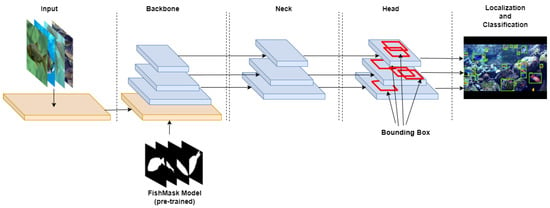
Figure 5.
The YOLO v5 FishDETECT model architecture.
5. Results and Discussion
5.1. Pre-Trained Models
In this work, four transfer learning models were passed to our model YOLO v5. The two models, YOLO v5 nano and YOLO v5 large, are two specific variants of YOLO v5 that are represented as a convolutional neural network architecture used for real-time object detection. COCO (Common Objects in Context) is a widely used database for object detection, semantic segmentation, and other computer vision-related tasks. COCO contains over 200,000 images annotated with 80 different object categories, making it a valuable dataset for training and evaluating object detection models. Our pre-trained model is the one we created manually in this study. Problems related to luminosity, scene clutter, and water density influence the quality of the fish images. Training on the fish masks instead of the real images can solve these problems and improve the performance of the model. As shown in Table 2, the performance of the final model is measured individually, with each model run in the context of transfer learning. The model training is carried out over 20 epochs. The performance of the model is measured at the 20th epoch with the Precision, Recall, and mAP50 metrics. The results obtained with YOLO v5 nano are the lowest. The values obtained are 0.832, 0.887, and 0.904, respectively. By applying transfer learning with coco, the model obtains the following values: 0.943, 0.967, and 0.971. YOLO v5 large improves the performance of the model by obtaining the values 0.948, 0.936, and 0.976. Finally, the results obtained with our pre-trained FishMask Model are the best compared to previous pre-trained models. Using the FishMask Model, our final model achieves very high accuracy values. At the 20th epoch, we obtained 0.962, 0.987, and 0.995 for the Precision, Recall, and mAP50 metrics, respectively. The visualization of the result in Figure 6 shows that the training of the FishDETECT model with our own pre-trained model is higher than the training with other existing models. The values of the mAP50 metric are plotted in curves describing the advances obtained in each training cycle.

Table 2.
FishDETECT model evaluation with the pre-trained models.
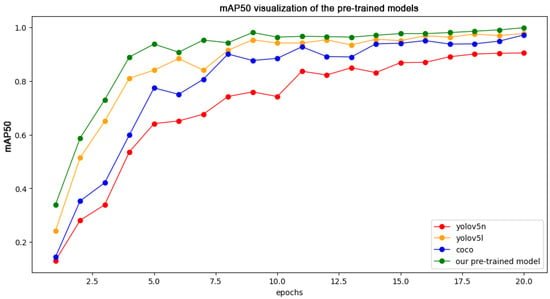
Figure 6.
The mAP50 visualization of the pre-trained models.
5.2. FishDETECT Model Performances
As mentioned in Table 2, the performance of the model is measured with different evaluation metrics. According to the values obtained with the Precision, Recall, and mAP50 metrics, and by transferring the learning from our own pre-trained FishMask model, the model performs well. Figure 7 describes the Precision–Confidence correlation, where Confidence is a numerical value that represents the probability that the detected object is actually present in the image. With a Confidence value of 0.1, the model can achieve an accuracy of 0.9. Gilt Head Bream is the most complicated species in the detection and recognition phase. The detection and classification of Shrimp is the simplest task for the model. The performance of the model is clearly shown in the confusion matrix found in Figure 8. The model achieves very high prediction rates ranging from 0.93 to 1.00. According to the confusion matrix, the model makes some misclassifications between fish species that look similar, such as Gilt Head Bream and Red Sea Bream or Black Sea Sprat and Horse Mackerel. Another slight kind of error is made between the detected fish and the background scene. These small confusions are explained by unclear vision of the scene, low light, poor water quality, and other weather conditions. Data augmentation and the addition of a validation split between the training and test phases solved the problems associated with overfitting. Figure 9 illustrates the training evolution of the model. In each training cycle, our model reduces the loss of object detection in the image.
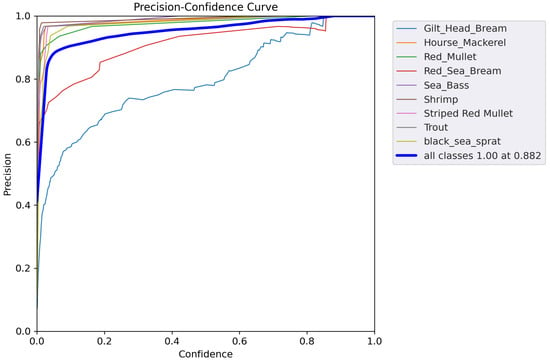
Figure 7.
The Precision–Confidence curve.
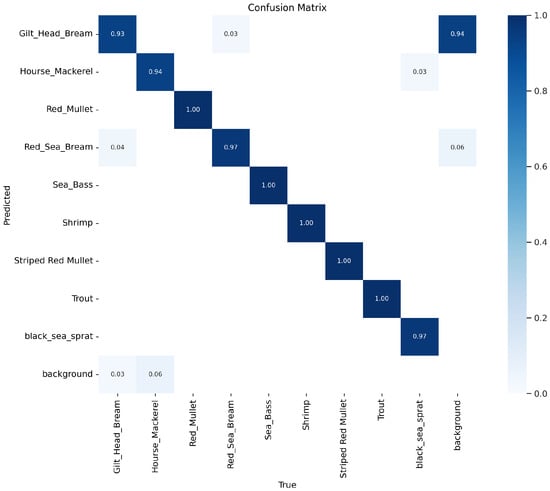
Figure 8.
The confusion matrix of FishDETECT model.
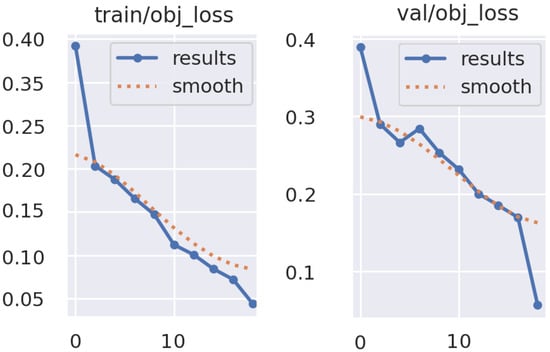
Figure 9.
The learning evolution of FishDETECT model.
5.3. Detection and Recognition Results
In the test phase, underwater videos were captured under different conditions. They were tested with our improved model. Figure 10 shows good-quality videos. The two scenes are captured for the Shrimp and Gilt Head Bream species. As shown in Figure 10, the species detection and classification are of high quality. The errors made by the model are very limited. Figure 11 shows a video taken for a swarm of Trout fish. The conditions are more complex, as the background resembles the color of the fish’s skin. As shown in the figure, the luminosity is very low and the water quality seems poor. Despite all these conditions influencing the effectiveness of a computer vision model, our improved model achieved successful detection and classification results.
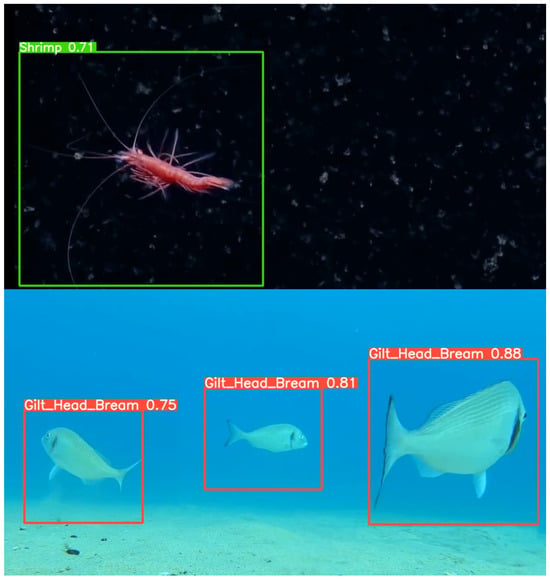
Figure 10.
Scenes captured in good conditions.
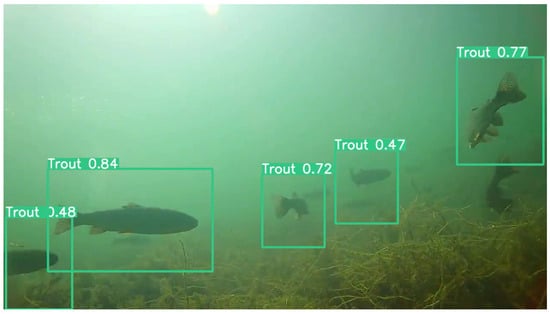
Figure 11.
Scene captured in poor conditions.
5.4. FishDETECT Model Integration into the Raspberry Pi-4
Our model demonstrated its competence by accurately classifying the different types of fish as Trout and Red Mullet with a confidence score of 0.63 and 0.77, respectively. Figure 12 shows the Raspberry Pi-4 board equipped with a camera module. Our FishDETECT model is integrated into this board. Figure 13 illustrates the fish detection phase and automatic recognition of its type in real time. This achievement highlights the potential of our system to make a significant contribution to underwater monitoring and management.
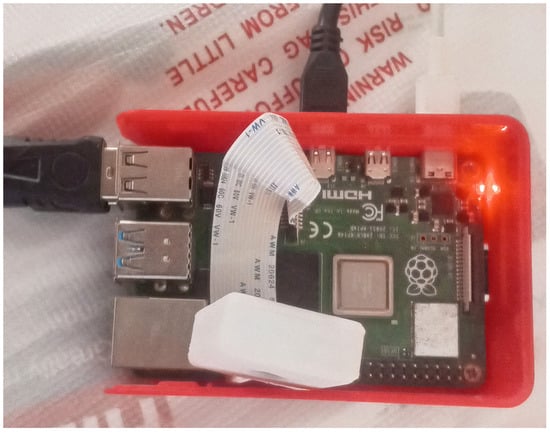
Figure 12.
Model integration into the Raspberry Pi-4 board.
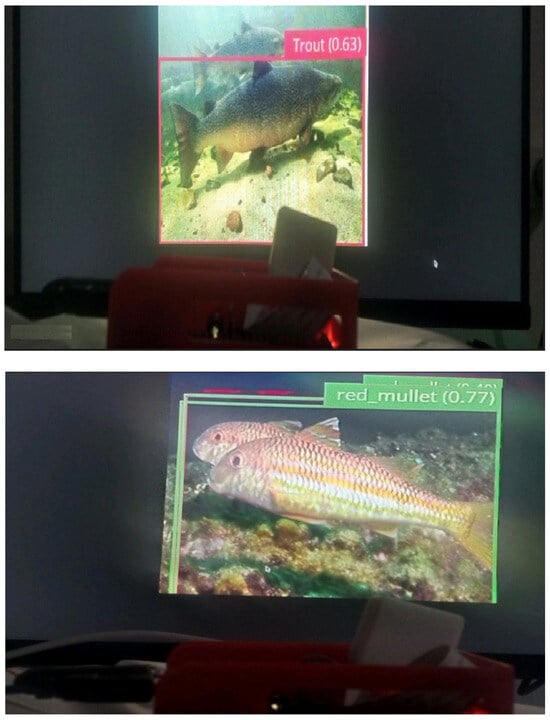
Figure 13.
Real-time detection visualization.
6. Further Discussion
To evaluate the performance of our improved model FishDETECT, the results of this study have been compared with several other similar studies in Table 3. An analysis was made to evaluate the methods used, the data characteristics, the performance indicators, and the results obtained. Based on these comparisons, the advantages and limitations of these fish species recognition methods are elaborated. After comparing our study with other similar work, we can conclude that all these studies detect fish types by applying computer vision techniques. None of the studies used challenges related to environmental conditions such as camouflage, low light, and poor water quality. Our model is broader. It can detect and classify fish species in both good and poor conditions. In addition, the majority of existing studies generally rely on outdated versions of object detection algorithms. However, our work develops a new approach based on YOLO v5 that uses a pre-trained model on fish image masks. This process has enabled us to obtain a preferred model that achieves an accuracy rate of . One of the main limitations of our study relates to the quality and quantity of the data used to train the models. The dataset contains biased or incomplete data. To overcome this problem, the use of emerging preprocessing techniques created by the Roboflow platform enabled us to improve the quality and quantity of the data in order to obtain a high-performance model.

Table 3.
Table of comparisons between this work and related studies.
7. Conclusions and Future Work
Given the complexity of the underwater environment, the efficiency of the fish detection and classification model is essential. In this paper, we propose a fish recognition solution based on an improved YOLO v5 model called FishDETECT. First, a new transfer learning model called FishMask Model is built. It is trained on a FishMask Dataset containing fish masks and their labels. The dataset is created in this work following the construction of a new model, the CarMask Model. The CarMask Model is trained with the U-Net image segmentation algorithm, which is based on deep learning. This dataset is labeled using the Roboflow platform. FishDETECT model uses the FishMask Model in transfer learning. The results obtained using the Precision, Recall, and mAP50 metrics are more beneficial than those obtained with a simple model based on YOLO v5 nano, YOLO v5 large, or COCO. Several delicate scenes have been tested with our model and we have achieved favorable results. In future work, our aim is to apply computer vision to identify fish diseases in real time. The model will be integrated into an embedded system for immediate interaction between the farmer and his intelligent farm.
Author Contributions
Conceptualization, M.H., M.O.-E.A., L.R. and R.B.; methodology, M.H., M.O.-E.A., L.R. and R.B.; software, M.H., M.O.-E.A., L.R. and R.B.; validation, M.H., M.O.-E.A., L.R. and R.B.; formal analysis, M.H., M.O.-E.A., L.R. and R.B.; investigation, M.H., M.O.-E.A., L.R. and R.B.; resources, M.H., M.O.-E.A., L.R. and R.B.; data curation, M.H., M.O.-E.A., L.R. and R.B.; writing—original draft preparation, M.H., M.O.-E.A., L.R. and R.B.; writing—review and editing, M.H., M.O.-E.A., L.R. and R.B.; visualization, M.H., M.O.-E.A., L.R. and R.B.; supervision, M.H., M.O.-E.A., L.R. and R.B.; project administration, L.R. All authors have read and agreed to the published version of the manuscript.
Funding
This research received no external funding.
Institutional Review Board Statement
Not applicable.
Informed Consent Statement
Not applicable.
Data Availability Statement
Not applicable.
Acknowledgments
Open Access funding provided by the Qatar National Library.
Conflicts of Interest
The authors declare no conflict of interest.
References
- Bhari, B.; Visvanathan, C.T. Sustainable aquaculture: Socio-economic and environmental assessment. In Sustainable Aquaculture; Springer: Cham, Switzerland, 2018; pp. 63–93. [Google Scholar]
- Stankus, A. State of world aquaculture 2020 and regional reviews: FAO webinar series. FAO Aquac. Newsl. 2021, 63, 17–18. [Google Scholar]
- Arechavala-Lopez, P.; Cabrera-Álvarez, M.J.; Maia, C.M.; Saraiva, J.L. Environmental enrichment in fish aquaculture: A review of fundamental and practical aspects. Rev. Aquac. 2022, 14, 704–728. [Google Scholar] [CrossRef]
- Conte, F.S. Stress and the welfare of cultured fish. Appl. Anim. Behav. Sci. 2004, 86, 205–223. [Google Scholar] [CrossRef]
- Li, D.; Li, X.; Wang, Q.; Hao, Y. Advanced Techniques for the Intelligent Diagnosis of Fish Diseases: A Review. Animals 2022, 12, 2938. [Google Scholar] [CrossRef]
- An, D.; Hao, J.; Wei, Y.; Wang, Y.; Yu, X. Application of computer vision in fish intelligent feeding system—A review. Aquac. Res. 2021, 52, 423–437. [Google Scholar] [CrossRef]
- Li, D.; Du, L. Recent advances of deep learning algorithms for aquacultural machine vision systems with emphasis on fish. Artif. Intell. Rev. 2022, 1, 1–40. [Google Scholar] [CrossRef]
- Olesen, I.; Myhr, A.I.; Rosendal, G.K. Sustainable aquaculture: Are we getting there? Ethical perspectives on salmon farming. J. Agric. Environ. Ethics 2011, 24, 381–408. [Google Scholar] [CrossRef]
- Lafont, M.; Dupont, S.; Cousin, P.; Vallauri, A.; Dupont, C. Back to the future: IoT to improve aquaculture: Real-time monitoring and algorithmic prediction of water parameters for aquaculture needs. In Proceedings of the Global IoT Summit (GIoTS), Aarhus, Denmark, 17–21 June 2019; pp. 1–6. [Google Scholar]
- Yang, L.; Liu, Y.; Yu, H.; Fang, X.; Song, L.; Li, D.; Chen, Y. Computer vision models in intelligent aquaculture with emphasis on fish detection and behavior analysis. Arch. Comput. Methods Eng. 2021, 28, 2785–2816. [Google Scholar] [CrossRef]
- Jalal, A.; Salman, A.; Mian, A.; Shortis, M.; Shafait, F. Fish detection and species classification in underwater environments using deep learning with temporal information. Ecol. Inform. 2020, 57, 101088. [Google Scholar] [CrossRef]
- Deep, B.V.; Dash, R. Underwater fish species recognition using deep learning techniques. In Proceedings of the 6th International Conference on Signal Processing and Integrated Networks (SPIN), Noida, India, 7–8 March 2019; pp. 665–669. [Google Scholar]
- Chakravorty, H.; Paul, R.; Das, P. Image processing technique to detect fish disease. Int. J. Comput. Sci. Secur. (IJCSS) 2015, 9, 121–131. [Google Scholar]
- Saberioon, M.; Gholizadeh, A.; Cisar, P.; Pautsina, A.; Urban, J. Application of machine vision systems in aquaculture with emphasis on fish: State-of-the-art and key issues. Rev. Aquac. 2017, 9, 369–387. [Google Scholar] [CrossRef]
- Storbeck, F.; Daan, B. Fish species recognition using computer vision and a neural network. Fish. Res. 2001, 51, 11–15. [Google Scholar] [CrossRef]
- Hu, J.; Li, D.; Duan, Q.; Han, Y.; Chen, G.; Si, X. Fish species classification by color, texture and multi-class support vector machine using computer vision. Comput. Electron. Agric. 2012, 88, 133–140. [Google Scholar] [CrossRef]
- Hridayami, P.; Putra, I.K.; Wibawa, K.S. Fish species recognition using VGG16 deep convolutional neural network. J. Comput. Sci. Eng. 2019, 13, 124–130. [Google Scholar] [CrossRef]
- Ju, Z.; Xue, Y. Fish species recognition using an improved AlexNet model. Optik 2020, 223, 165499. [Google Scholar] [CrossRef]
- Dos Santos, A.A.; Gonçalves, W.N. Improving Pantanal fish species recognition through taxonomic ranks in convolutional neural networks. Ecol. Inform. 2019, 53, 100977. [Google Scholar] [CrossRef]
- Alaba, S.Y.; Nabi, M.M.; Shah, C.; Prior, J.; Campbell, M.D.; Wallace, F.; Ball, J.E.; Moorhead, R. Class-aware fish species recognition using deep learning for an imbalanced dataset. Sensors 2022, 22, 8268. [Google Scholar] [CrossRef]
- Ovalle, J.C.; Vilas, C.; Antelo, L.T. On the use of deep learning for fish species recognition and quantification on board fishing vessels. Mar. Policy 2022, 139–105015. [Google Scholar] [CrossRef]
- Redmon, J.; Divvala, S.; Girshick, R.; Farhadi, A. You only look once: Unified, real-time object detection. In Proceedings of the IEEE Conference on Computer Vision and Pattern Recognition, Las Vegas, NV, USA, 26 June–1 July 2016; pp. 779–788. [Google Scholar]
- Du, J. Understanding of object detection based on CNN family and YOLO. J. Phys. 2018, 1004–012029. [Google Scholar] [CrossRef]
- Diwan, T.; Anirudh, G.; Tembhurne, J.V. Object detection using YOLO: Challenges, architectural successors, datasets and applications. Multimed. Tools Appl. 2023, 82, 9243–9275. [Google Scholar] [CrossRef]
- Wageeh, Y.; Mohamed, H.E.; Fadl, A.; Anas, O.; ElMasry, N.; Nabil, A.; Atia, A. YOLO fish detection with Euclidean tracking in fish farms. J. Ambient. Intell. Humaniz. Comput. 2021, 12, 5–12. [Google Scholar] [CrossRef]
- Buric, M.; Pobar, M.; Ivasic-Kos, M. Ball detection using YOLO and Mask R-CNN. In Proceedings of the International Conference on Computational Science and Computational Intelligence (CSCI), Las Vegas, NV, USA, 13–15 December 2018; pp. 319–323. [Google Scholar]
- Hu, H.; Tang, C.; Shi, C.; Qian, Y. Detection of residual feed in aquaculture using YOLO and Mask RCNN. Aquac. Eng. 2023, 100, 102304. [Google Scholar] [CrossRef]
- Park, J.H.; Kang, C. A study on enhancement of fish recognition using cumulative mean of YOLO network in underwater video images. J. Mar. Sci. Eng. 2020, 8, 952. [Google Scholar] [CrossRef]
- Zhang, Y.; Guo, Z.; Wu, J.; Tian, Y.; Tang, H.; Guo, X. Real-time vehicle detection based on improved yolo v5. Sustainability 2022, 14, 12274. [Google Scholar] [CrossRef]
- Szeliski, R. Computer Vision: Algorithms and Applications; Springer Nature: Berlin/Heidelberg, Germany, 2022. [Google Scholar]
- Ronneberger, O.; Fischer, P.; Brox, T. U-net: Convolutional networks for biomedical image segmentation. In Proceedings of the Medical Image Computing and Computer-Assisted Intervention—MICCAI, Munich, Germany, 5–9 October 2015; Volume 18, pp. 234–241. [Google Scholar]
- Villa, M.; Dardenne, G.; Nasan, M.; Letissier, H.; Hamitouche, C.; Stindel, E. FCN-based approach for the automatic segmentation of bone surfaces in ultrasound images. Int. J. Comput. Assist. Radiol. Surg. 2018, 13, 1707–1716. [Google Scholar] [CrossRef]
- He, K.; Gkioxari, G.; Dollár, P.; Girshick, R. Mask r-cnn. In Proceedings of the IEEE International Conference on Computer Vision, Venice, Italy, 22–29 October 2017; pp. 2961–2969. [Google Scholar]
- kaggle. Carvana Image Masking (PNG). Available online: https://www.kaggle.com/datasets/ipythonx/carvana-image-masking-png (accessed on 31 August 2023).
- Raza, K.; Song, H. Fast and accurate fish detection design with improved YOLO-v3 model and transfer learning. Int. J. Adv. Comput. Sci. Appl. 2020, 11, 7–16. [Google Scholar] [CrossRef]
- Kuswantori, A.; Suesut, T.; Tangsrirat, W.; Schleining, G.; Nunak, N. Fish Detection and Classification for Automatic Sorting System with an Optimized YOLO Algorithm. Appl. Sci. 2023, 13, 3812. [Google Scholar] [CrossRef]
- Liu, Y.; Chu, H.; Song, L.; Zhang, Z.; Wei, X.; Chen, M.; Shen, J. An improved tuna-YOLO model based on YOLO v3 for real-time tuna detection considering lightweight deployment. J. Mar. Sci. Eng. 2023, 11, 542. [Google Scholar] [CrossRef]
- Adiwinata, Y.; Sasaoka, A.; Bayupati, I.A.; Sudana, O. Fish species recognition with faster r-cnn inception-v2 using qut fish dataset. Lontar Komput. J. Ilm. Teknol. Inf. 2020, 11, 144–154. [Google Scholar] [CrossRef]
- Zhao, Z.; Liu, Y.; Sun, X.; Liu, J.; Yang, X.; Zhou, C. Composited FishNet: Fish detection and species recognition from low-quality underwater videos. IEEE Trans. Image Process. 2021, 30, 4719–4734. [Google Scholar] [CrossRef]
Disclaimer/Publisher’s Note: The statements, opinions and data contained in all publications are solely those of the individual author(s) and contributor(s) and not of MDPI and/or the editor(s). MDPI and/or the editor(s) disclaim responsibility for any injury to people or property resulting from any ideas, methods, instructions or products referred to in the content. |
© 2023 by the authors. Licensee MDPI, Basel, Switzerland. This article is an open access article distributed under the terms and conditions of the Creative Commons Attribution (CC BY) license (https://creativecommons.org/licenses/by/4.0/).